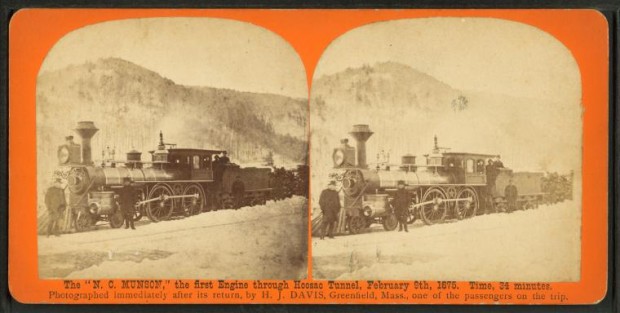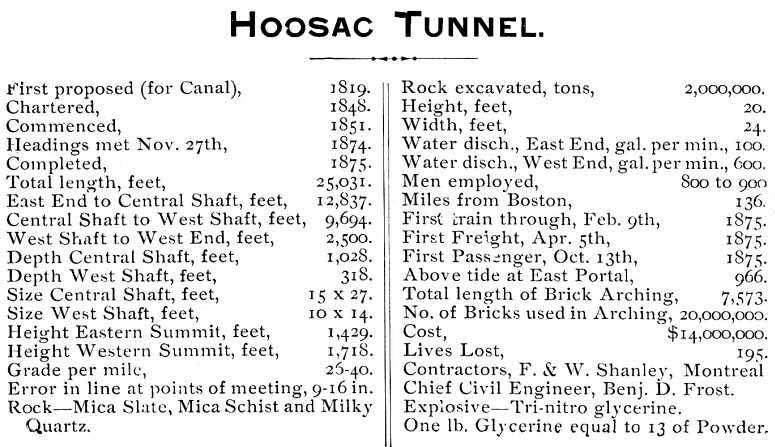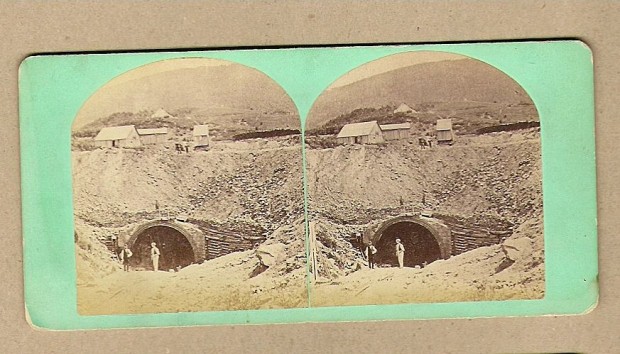
Guest contributor: John Clayton
Serial Sunday: “Hoosac Tunnel,” a story by John J. Clayton
categories: Cocktail Hour
1 comment
Because it matters so much whether the train comes through the tunnel when the children are still inside, in another sense it doesn’t matter at all: either way, nobody’s life will be the same.
Certainly not mine.
The Hoosac Tunnel, four and a half miles through the Berkshires, East to West.
Either six sets of parents—seven including the counselor’s—mourn their lost children the rest of their lives, and brothers mourn brothers and friends mourn friends—or else they’re made aware how close they were to mourning. And so, how close they are, how close we all are. I think about my brother. I think about the brother who grew up . . . or brother lost. And I think about the future mates of those children, and the children of those children. And suppose a great-great grandchild will find, or might have found, a way to extract hydrogen cheaply or to cure childhood leukemia, and suppose a child who would have died from leukemia will live to make great music, or would have lived to make great music—a Mozart.
So either way the same: no one can forget the fragility of a child’s life, lo st or not lost, nor the way moments reverberate.
st or not lost, nor the way moments reverberate.
Or maybe it’s not true the parents can’t forget. Imagine that the train stops outside the tunnel, held up by the State Police. The light is from the State Police car that has driven into the tunnel. The children are safe. And now it’s fifteen years later and the original terror has dwindled into laughter over an anecdote. Everyone safe, essentially nothing happened. And some parents do forget, forget the original terror. The call from the camp. They complain, oh, that their grown children have moved away; they feel insulted by a son-in-law. They worry about their stock portfolios.
Or else the children were there in the tunnel when the train roared through, and in terror pressed up against the wall, and one, then another, was sucked into the train as if the tunnel were the tube of a giant vacuum cleaner, and others were suffocated by carbon monoxide from the diesel exhaust. And the parents of those children died too; nothing will ever be the same. And what about parents whose children barely survived? Oh, they say, oh, now I see what life is.
I think of that tunnel often. My brother Joel, twelve years old, was one of the six children, four girls, two boys, in the group from camp.
“Who wants to go take a look at the Hoosac Tunnel?”
There were two counselors. The older one, who’d thought it up, had heard about the tunnel, not far from camp. Until they brought the railroad through the Rockies , the Hoosac was the longest tunnel in America, four and a half miles eastern to western ends. What an adventure—walking over four and a half miles in the dark while sunlight withdraws to a pinprick you can see for almost a mile, and maybe ghosts appear. I don’t think the young man knew the mileage, and I don’t think he’d heard about the ghosts—he was from New York City. Tim, the counselor, he’s like the pied piper who led the town’s children into the mountain, seducing them to follow. But Tim seduced them out of curiosity, a sense of fun, not revenge (in the original story, the townspeople wouldn’t pay the piper for getting rid of their rats, and the piper called their children under the mountain).
, the Hoosac was the longest tunnel in America, four and a half miles eastern to western ends. What an adventure—walking over four and a half miles in the dark while sunlight withdraws to a pinprick you can see for almost a mile, and maybe ghosts appear. I don’t think the young man knew the mileage, and I don’t think he’d heard about the ghosts—he was from New York City. Tim, the counselor, he’s like the pied piper who led the town’s children into the mountain, seducing them to follow. But Tim seduced them out of curiosity, a sense of fun, not revenge (in the original story, the townspeople wouldn’t pay the piper for getting rid of their rats, and the piper called their children under the mountain).
I see them straggling out of the beat-up camp van down the bracken-thick trail and along the tracks, the kids hot and sweaty and half wondering what they’re doing there and half excited, and the counselor, Tim, embarrassed: he’s got them there, but why? Just to look at a hole, entrance to a tunnel for trains? He hadn’t planned to go through, but now it seemed an adventure, and he’d brought along a flashlight. And of course trains don’t use these tracks anymore, do they? And then one of the kids walked in and yelled to raise echoes. So the young man told the younger counselor: “Why don’t you drive the van over the mountain and meet us at the western entrance? You’ll find it. Just ask. I think it’s in North Adams.” Maybe he had a map, but if he did, wouldn’t he have seen how absurd the distance for six kids in the dark? The van drove off; now the young man was stuck. “All right. Come on guys, let’s do it.” The children followed; he led the way with a flashlight.
Early in the nineteenth century a project was approved by the Massachusetts legislature to open the west to Boston by creating a railroad tunnel through Hoosac Mountain in the Berkshires. Work began in 1851, and after delays and false starts, was finished long after the Civil War in 1874. A great feat of nineteenth century engineering, it involved drilling and blasting first through hard rock, then wet schist—the men called it oatmeal. The tunneling from east and the tunneling from west met beautifully, with only 9/16 of an inch error. But there were other errors. Out of eight or nine hundred men who worked on the tunnel, one hundred ninety six died—died from rock slides, from asphyxiation, and from explosions of nitroglycerine, used commercially for the first time. It’s their ghosts said to haunt the tunnel.

Even fiction needs some facts…
Soon forty trains a day were coming through. Then fewer, fewer, as trucks carried the load and railroads grew less important. The technology of one age becomes the romance of the next. It’s romance the young man is after. Caving through the dark hill. Poking a light up to see the brickwork used to surface the walls when the solid rock turned to schist. The young man, in anthropology at Columbia, imagines men sweating down here, imagines the dust and damp as they embedded the brick.
The tunnel, he can see as soon as they walk in, wasn’t built for foot traffic. It’s too narrow. What do we do if a train comes? Press against the wall? Will there be room? Of course a train won’t come, but what if? They walk on tiptoe through mud, through pools of filthy water. God. We should have hard hats against falling bricks, the young man thinks. It’s clammy. But he’s sweating now mostly from anxiety. As the pinprick of sunlight dissolves into darkness, all of a sudden he knows: he’ll lose his job. Nothing to do about it.
After a while they can see pretty well in the dark, avoiding the litter between the tracks. Bricks, garbage, detritus from trains—not much romance after all. Clammy: breath comes cold and thick. “Yuck,” a girl says. And someone else: “How much further?”
As a kid Joel liked backpacking; when I was home from college he made me go wilderness camping with him. He loved climbing—rock climbing, tree climbing. By twelve he was a Star Scout. He was an imaginative child, a storyteller, an explorer. This was his kind of adventure.
Ahead, a white light. “There, that looks like the end!” The children run ahead, and Tim calls to them, “Wait! Wait up!”—but voice dissolves into drone in the dark. And he can barely see them. With flashlight he sees shadows.
The light is closer now, and they can see it’s just an electric light high up on a wall.
As they go on and on, an hour, two, they begin to look over their shoulders. There’s another light up ahead. And they walk on. Again it’s a lamp. But what’s that up ahead?
The tunnel is absolutely straight, end to end. Yet in another sense not at all straight; a dark maw of possibilities swallows sound and shape; and within, invisible branches lead to invisible branches. From time to time, the children come upon niches carved in the wall where track walkers used to flatten themselves for trains to pass in case they were caught in the tunnel. The engineer couldn’t see much, couldn’t hear much: sound is swallowed up. If something went wrong—say rock or brick on the tracks—the track walkers would affix small charges to the rail, to explode when the train passed over; that would make enough noise to get the engineer to stop the train.
What can stop the train now? Maybe someone sees them walking in. There are no houses nearby, but cars pass pretty often on the two-lane road that goes along the Deerfield River. Maybe there’s a fisherman or a kayaker looking for a spot to put in, and he thinks, What are those kids doing? Or the other counselor finds the Western entrance in North Adams, and he waits, he waits, and waiting, he begins to get uneasy. And he goes to the tunnel mouth and yells. And someone, an old man, a local, notices and stops. Says, They’re doing WHAT? And the counselor drives to a phone, hands shaking so hard he has trouble dropping in the coins, but finally he calls the Police, and the light that the children see in the tunnel, it’s strobe light, red and blue and white. The State Police have called to block the train that’s nearly at the Western end of the tunnel. And it’s a State Police car that greets the kids at the mouth. And no one’s known enough to be really scared. “Most of you would have been killed,” the cop says. “Sucked into the train or suffocated.” He backs out of the tunnel and the kids follow him. Into life. And the counselors are both sent home.
Or no one sees. No one stops the train, and the other counselor, standing by the Western mouth, tries to flag down the train that’s creeping around a bend towards the tunnel. He screams, he waves his arms, he points, but the engineer doesn’t see him or doesn’t understand. And now, fifteen years later, living his life, playing with his son, the counselor replays the afternoon, and in this replaying he realizes what’s going on and calls the State Police in time.
But he didn’t call. And somewhere in the last mile of the tunnel the children feel the vibration and the pressure of air; there is no roar until the train is upon them. The engineer hears nothing, doesn’t see the flailing of the hands until too late—or not at all.
Or did he really call? Suppose he did. If so, playing ball with his little boy, he thinks back to his humiliation, losing his job that day; but at least the kids were safe, thank God.
Why can’t I tell you? Because there is no closure for me. Everyday, you decide to drive by this road and not that road, and on that road there’s a seven-car pile-up. Joel got married last night, and me, I’m a little hung over this morning, a little depressed, and I think what might have happened. Or there is no Joel; I grew up with my missing brother more real in my life than anyone.
It matters so much whether the train comes through that tunnel when the children are still inside, matters so much that in one sense it doesn’t matter at all. Accident not happening is accident. Either way, the same: nobody’s life ever again the same.
 [John J. Clayton is a radiant novelist living in western Massachusetts. This story is part of his story-a-month-email project. He’s the author of a number of novels and story collections, including “Mitzvah Man” and “Radiance.” He write, “Did I tell you that the incident is real? It is. In real life the kid called the State Police, a train really was held up and would have killed the kids, and all was well. But it’s important in the story that we don’t know and that either way everything changes.”
[John J. Clayton is a radiant novelist living in western Massachusetts. This story is part of his story-a-month-email project. He’s the author of a number of novels and story collections, including “Mitzvah Man” and “Radiance.” He write, “Did I tell you that the incident is real? It is. In real life the kid called the State Police, a train really was held up and would have killed the kids, and all was well. But it’s important in the story that we don’t know and that either way everything changes.”


Heart-wrenching. This one really gripped me.
Is this story a lark, or is the terror I feel real – it’s hard not knowing.
Well done!